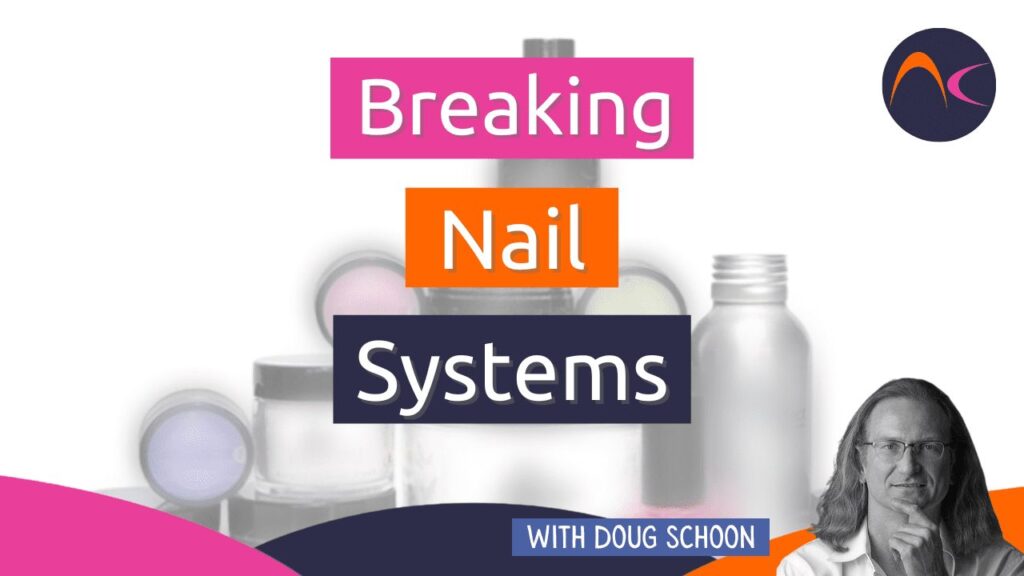We all know that breaking nail systems is not the way to go. But many have done it without harm, as far as they can tell. So, how far does the term “system” stretch? Does adding pigments count as breaking nail systems, for example?
Any company would like you to apply their nail polish to their enhancement products, and to use their nail oil or hand lotion. But these aren’t the systems I’m concerned about. I’m talking about matched pairs of products that are designed to be used together in order to function properly and safely. Good examples are monomer liquid and polymer powder, or UV gels and nail lamps. Even primers, removers, and nail prep products are often formulated and tested to ensure they work well together and are compatible. This really isn’t about breaking nail systems; it is actually about following directions.
Adding something to a nail powder or UV gel that wasn’t designed for that product may mean you’re using it incorrectly. The nail professional is skipping all the testing a manufacturer would normally do to ensure an additive is safe and effective. Just because nothing happens when this is done, doesn’t mean much. I can close my eyes for 30 seconds while driving. Just because I don’t have an accident, doesn’t mean that driving with my eyes closed is safe or wise.
Often there are long-term consequences related to something a nail professional started doing a year ago. For instance, some clients may take many months or even years to develop an allergic reaction. Small changes may affect only a small percentage of clients, causing them to have service breakdown. Often nail professionals blame such problems on something the client is doing. Many times it’s related to something they changed months ago.
When product lines are mixed together and not used as they were designed, unexpected consequences can occur. Don’t expect some kind of warning. Instead understand that you’ve created a situation where something unexpected and surprising may eventually happen. This could put you and your clients at increased risk for something going wrong. It may not happen today, maybe not tomorrow, but maybe in a month or a few years. Perhaps it will be a combination of several changes over time that will trigger unexpected problems. This isn’t just speculation, I’ve seen this happen many times.
When the issue occurs, the nail professional has no idea how to solve the problem. Why? Because it is related to many things they are doing and not just one.
Here is an example: a nail professional may decide to mix a pigment into her UV gel and doesn’t notice any problems over the next month. A few months later, she buys some nail foils at a trade show and still doesn’t notice any problems. She reads on the Internet about a new UV base gel someone is raving about, so she tries it. Then she buys a different UV nail lamp that’s on sale when the old one wears out. Six months later, she notices that several of her client’s nails are breaking more easily. She’s doing more repairs than ever before. A few clients develop oddly discolored nail plates and several are becoming sensitive, the skin around their nails is red and swollen or the nail bed is feeling tight or itchy.
What’s going on and how can she solve these problems? Many struggle with such problems all the time and don’t ever solve them. These things happen all the time and I get questions on a weekly basis. Over the years I’ve noticed that nail professionals rarely think it is something they are doing. Most blame the products or the clients.
Anyone who’s ever educated for a nail company or worked their company’s Educational Hotline can tell you a hundred stories like this. It might be something the client is doing or a defective product. But in my experience, most often it’s something the nail technician is doing/not doing. Skin reactions usually occur because nail professionals make up their own directions, mixing different product lines together, creating their own blends, or improperly applying, curing, or removing the nail coatings. I understand that nail professionals consider themselves artists and want to be creative, but painting a canvas or sculpting in wood is not the same as working on someone’s nails and skin.
Many have left the industry because they couldn’t keep clients. Many ex-clients tell their friends to avoid artificial nail coatings because of all the problems they’ve experienced. Until nail professionals become more educated about these issues and begin to follow directions more carefully, these problems will continue to plague the nail industry. My hope is that you will help solve this problem by educating yourself and others about the importance of using professional nail products properly and safely.


